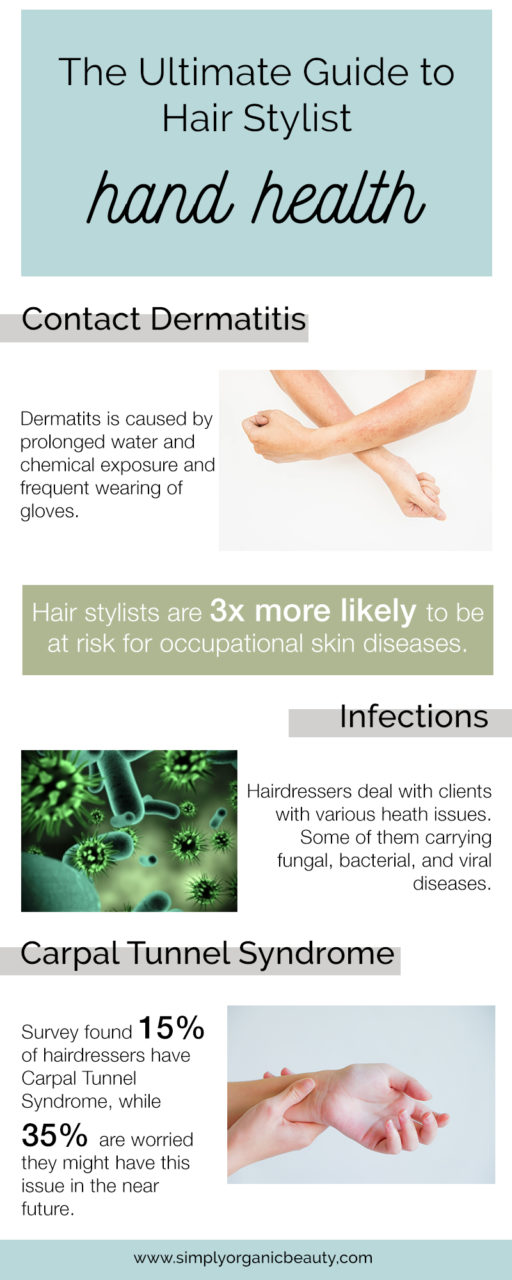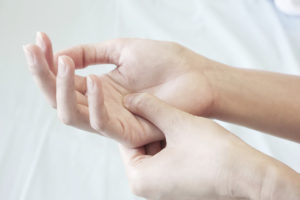As hair stylists, many of us still work with products containing harsh chemicals for hours on end, exposing ourselves to various health hazards in the process. Additionally, our wrists and hands are in constant motion and remain wet for long periods of time which reduces the skin’s protective barrier, making it easy for irritating substances to penetrate the skin.
According to Hairfinder, 1 of every 5 hair stylists will suffer an illness related to their occupation. These conditions range from respiratory problems to increased cancer risks in hair stylists, but these three most common health concerns affect our greatest assets—our hands.
Hair Stylist Hand Conditions to Watch Out For
Contact Dermatitis
A European study revealed that hairdressers are three times more likely to be at risk for occupational skin diseases than other professions. One of them is Contact Dermatitis, which is caused by prolonged water and chemical exposure and frequent wearing of gloves.
Dermatitis can be triggered by chemicals like ammonia, artificial colorants, synthetic fragrance and high amounts of paraphenylenediamine (PPD) in many hair color brands. Unfortunately, once you develop sensitivity to these chemicals, it won’t go away. Even the slightest exposure to allergens can cause dermatitis to flare up. Not to mention, many of us hair stylists require heavy doses of steroids, antihistamines and Benadryl just to do the work we love.
Symptoms may vary, but these are the most common signs that you may have contact dermatitis:
- Red skin
- Itchiness
- Burning and sun sensitivity
- Localized swelling of the skin, such as blisters and lesions
- Dryness, flaking, and fissuring may occur.
Fungal, Bacterial & Viral Infections
As hairdressers, we spend a lot of time handling tools and hair, which can be reservoirs of infection whether fungal, bacterial or viral. Diseases such athlete’s foot, yeast, staphylococcus, streptococcus, and pseudomonas are just a few of the many infections that can be transmitted into our salons.
Fungal and bacterial infections are far easier to spot than viral ones. For example, viral infections like herpes, Hepatitis C and even HIV can find their way into our system without detection. Therefore, taking extra precautions, especially when there’s a broken skin involved, is needed to prevent contamination and transmission of disease.
If we fail to identify any symptom and impose proper safety measures, we (including our other clients) become susceptible to diseases.

Carpal Tunnel Syndrome

Many hair stylists are plagued by Carpal Tunnel Syndrome – a painful ailment that affects the nerves and muscles in the hands. In fact in 2014, Modern Salon’s Healthy Hairdresser Survey has found that 15% of hairdressers have Carpal Tunnel Syndrome, while 35% are worried they might have this issue in the near future.
We subject our hands to repetitive stress and motions, causing damage to tissues of the wrist. While it can be fixed through surgery, there still can be a lot of complications which, in severe cases, can cut short your beauty career.
How to Avoid These Common Hair Stylist Ailments
These health issues are pretty alarming for sure, but there are a few pre-emptive measures we can do to prevent them from happening, such as:
1. Make sure your tools are regularly cleaned and sterilized, especially when a client with fungal, viral, or bacterial infection enters your salon.
2. Avoid salon products that contain harsh chemicals like ammonia, synthetic fragrance and high amounts of PPD. Here at Simply Organic Beauty, all our professional organic salon products are completely free of ammonia, and PPD-free hair color alternatives are available for those sensitive to this ingredient.
3. Keep your hands nourished by applying protective creams that contain vitamin E and Omega-3, like Oway Remedy Hand Balm. They help strengthen the skin’s lipid barrier function while restoring its vital moisture levels.
4. Massage your arms and hands whenever you feel tired to keep the blood flowing. Moderate exercise like yoga is also perfect for relieving stress from pain points and joints.
5. Visit your physician for regular checkups. After all, prevention is still better than consuming heavy amounts of medications.





